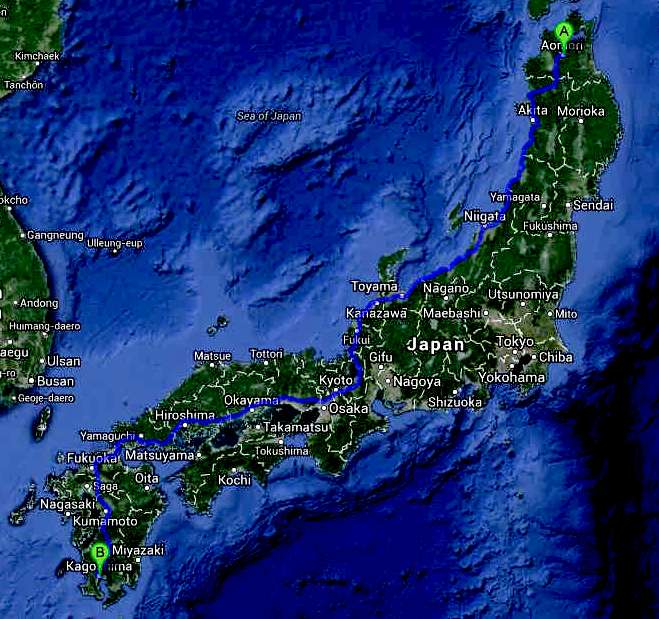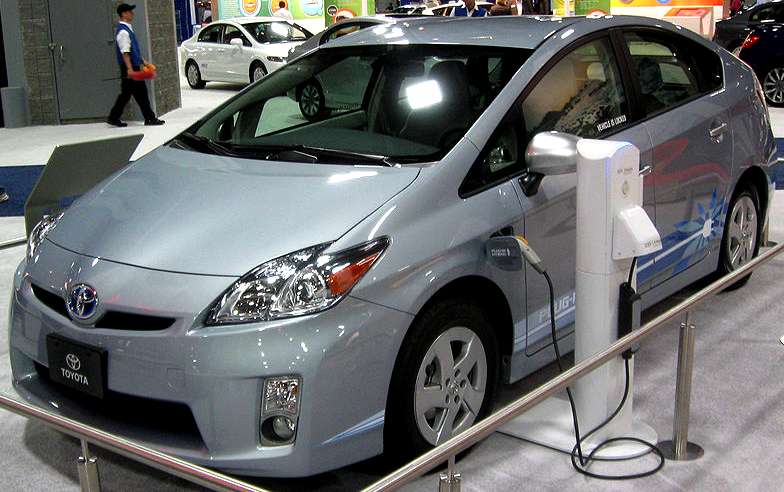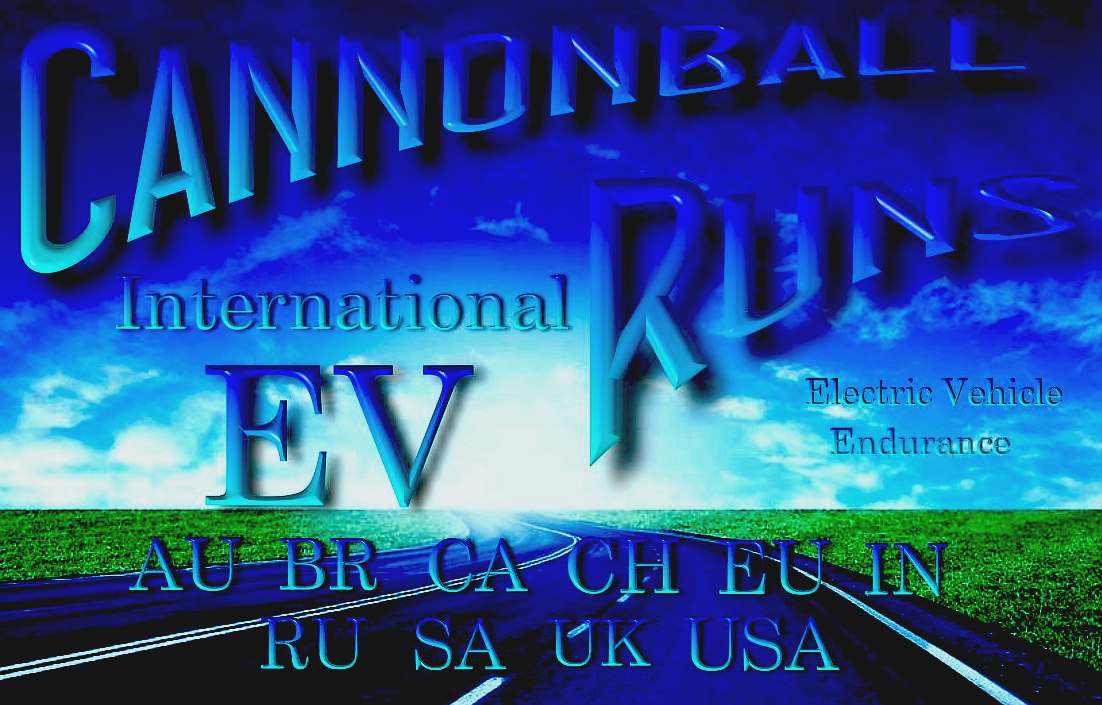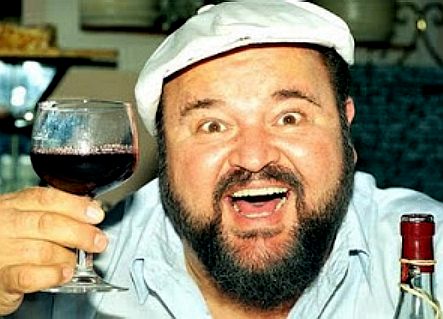CANNONBALL
INTERNATIONAL EV ROAD TRIP SERIES
The
Cannonball International EV Run™ series is for battery or hydrogen fuel cell powered
electric vehicles (any zero emission vehicle) that are based on ordinary production vehicle running
gear and must be capable of carrying a passenger. They may be solar
assisted, provided that the solar panel area does not exceed four square
meters - a rule that may be relaxed as we learn from experience. See
the full Cannonball EV rules HERE.
These
rules are designed to promote the development of an international EV infrastructure, as a means of accelerating the transition from IC
engines to clean electric motors, especially in countries that do not
have abundant sunshine, where support for non-solar assisted
electric vehicles is all the more important.

Map
of the Trans-Japan Cannonball International EV Run
AOMORI
to KAGOSHIMA - TRANS-JAPAN CANNONBALL EV RUN SUGGESTED STOPS
|
START |
AOMORI |
NORTH
JAPAN |
MILES |
KM |
|
1st
STOP |
Odate |
Akita |
53.1 |
85 |
|
2nd
STOP |
Akita |
Akita |
118 |
190 |
|
3rd
STOP |
Sakata |
Yamagata |
187 |
301 |
|
4th
STOP |
Kashiwazaki |
Niigata |
340 |
547 |
|
5th
STOP |
Komatsu |
Ishikawa |
494 |
795 |
|
6th
STOP |
Kyoto |
Kyoto Prefecture |
636 |
1,023 |
|
7th
STOP |
Kasaoka |
Okayama |
786 |
1,265 |
|
8th
STOP |
Hiroshima |
Hiroshima |
854 |
1,372 |
|
9th
STOP |
Koga |
Fukuoka |
1,016 |
1,635 |
|
10th
STOP |
Uki |
Kumamoto |
1,102 |
1,773 |
|
FINISH |
KAGOSHIMA |
SOUTH
JAPAN |
1,195 |
1,923 |
GOOGLE
SUGGESTED ROUTE - Driving directions
(This route has tolls)
AOMORI
- JAPAN
| 1.
Head east |
217
ft |
| 2.
Turn right
toward 旧線路通り |
0.1
mi |
| 3.
Turn right at
中央二丁目(交差点)
onto 旧線路通り
|
0.2
mi |
| 4.
Turn
left onto 青森中央大橋/
県道120号線
Continue to follow 県道120号線 |
1.6
mi |
| 5.
Turn left at
荒川字藤戸(交差点)
onto 国道7号バイパス/
国道7号線 |
0.4
mi |
| 6.
Turn
left onto the ramp to 青森自動車道
(Toll road)
|
0.2
mi |
| 7.
Keep
right at the fork, follow signs for 弘前・盛岡
and merge onto 青森自動車道
(Toll road)
|
4.4
mi |
| 8.
Continue
onto 東北自動車道
- (Toll road) |
28.5 mi
|
| 9.
Take
exit 高速碇ヶ関IC
toward 碇ケ関出口
(Toll road)
|
0.6 mi
|
| 10.
Turn left at 東北道碇ヶ関入口(交差点)
onto 羽州街道/
国道7号線
(signs for 大館・秋田) |
12.9 mi
|
| 11.
Turn right
at
釈迦内(交差点)
onto 秋田自動車道/
国道7号線 |
2.9 mi
|
| 12.
Take the
exit toward
大館南バイパス/
国道103号線 |
0.5 mi
|
| 13.
Keep right
at the fork and merge onto
大館南バイパス/
国道103号線 |
1.4 mi
|
| 14.
Turn
left at 立花(交差点)
onto 羽州街道(秋田街道)/
国道7号線
Continue to follow
国道7号線 |
19.0 mi
|
| 15.
Take the
ramp onto 琴丘能代道路(無料区間) |
10.5 mi
|
| 16.
Continue
onto 琴丘能代道路
(Toll road)
|
10.7 mi
|
| 17.
Take
the ramp onto 秋田自動車道
(Toll road)
|
12.7 mi
|
| 18.
Take
exit 高速昭和男鹿半島IC
on the right to merge
onto 秋田外環状道路
(Toll road)
|
5.9 mi
|
| 19.
Take
the ramp onto 秋田自動車道
(Toll road)
|
11.7 mi
|
| 20.
Take
exit 河辺JCT
toward 日本海東北道・本荘・酒田
(Toll road)
|
0.6 mi
|
| 21.
Merge
onto 日本海東北自動車道
(Toll road)
|
10.4 mi
|
| 22.
Continue
onto 日本海東北自動車道(無料区間) |
13.3 mi
|
| 23.
Continue
onto 仁賀保本荘道路(無料区間) |
7.5 mi
|
| 24.
Continue
onto 象潟仁賀保道路(無料区間) |
4.2 mi
|
| 25.
Take the
ramp to 金浦バイパス/
国道7号線 |
0.5 mi
|
| 26.
Turn
left onto 金浦バイパス/
国道7号線
(signs for 酒田)
Continue to follow 国道7号線 |
22.6
m
|
| 27.
Turn left
onto
県道59号線 |
1.3 mi
|
| 28.
Turn
right to merge onto 日本海東北自動車道
(Toll road)
|
20.0 mi
|
| 29.
Continue
onto 日本海東北自動車道(無料区間) |
12.9 mi
|
| 30.
Take the
exit |
0.5 mi
|
| 31.
Turn left
(signs for 市内大岩川) |
0.7 mi
|
| 32.
Turn left
toward
羽州浜街道/
国道7号線 |
0.3 mi
|
| 33.
Turn right
toward
羽州浜街道/
国道7号線 |
89 ft
|
| 34.
Turn
left onto 羽州浜街道/
国道7号線
Continue to follow 国道7号線
|
27.3 mi
|
| 35.
Turn left at
猿沢(交差点)
onto 県道208号線
|
0.2 mi
|
| 36.
Turn right
to merge onto 日本海東北自動車道(無料区間) |
12.9 mi
|
| 37.
Continue
onto 日本海東北自動車道
(Toll road)
|
28.8 mi
|
| 38.
Take
exit 新潟中央JCT
on the right toward 北陸道・関越道・富山・東京
(Toll road)
|
0.5 mi
|
| 39.
Merge
onto 北陸自動車道
(Toll road)
|
296 mi
|
| 40.
Take
exit 米原JCT
on the right toward 名神・彦根・京都
(Toll road)
|
0.6 mi
|
| 41.
Merge
onto 名神高速道路
(Toll road)
|
66.8 mi
|
| 42.
Take
exit 吹田JCT
toward 中国道・山陽道・宝塚・岡山
(Toll road)
|
1.1 mi
|
| 43.
Merge
onto 中国自動車道
(Toll road)
|
18.8 mi
|
| 44.
Take
exit 神戸JCT
toward 山陽道・岡山・徳島
(Toll road)
|
0.9 mi
|
| 45.
Merge
onto 山陽自動車道
(Toll road)
|
192 mi
|
| 46.
Take
exit 廿日市JCT
on the right toward 山陽道・岩国・北九州
(Toll road)
|
0.9 mi
|
| 47.
Merge
onto 広島岩国道路
(Toll road)
|
7.3 mi
|
| 48.
Take
the ramp onto 山陽自動車道
(Toll road)
|
59.2 mi
|
| 49.
Take
exit 山口JCT
on the right toward 中国道・下関・北九州
(Toll road)
|
0.8 mi
|
| 50.
Merge
onto 中国自動車道
(Toll road)
|
39.9 mi
|
| 51.
Continue
onto 関門橋
(Toll road)
|
5.9 mi
|
| 52.
Continue
onto 九州自動車道
(signs for 九州道・福岡・熊本)
(Toll road)
|
212 mi
|
| 53.
Take
exit 高速鹿児島北IC
toward 国道3号線
(Toll road)
|
0.2 mi
|
| 54.
Turn left at
鹿児島北インター(交差点)
onto 国道3号線
(signs for 鹿児島市街・桜島フェリー) |
2.4 mi
|
| 55.
Keep right
to stay on 国道3号線 |
0.2 mi
|
| 56.
Turn left at
平田橋(交差点)
onto 中之平通り/
国道3号線 |
0.5 mi
|
| 57.
At 照国神社前(交差点),
continue onto 国道10号線 |
0.1
mi |
| 58.
Turn right
at 中央公民館前(交差点)
onto 朝日通り/
国道58号線 |
0.2
mi |
| 59.
Turn left at
朝日通り(交差点) |
0.1
mi |
| 60.
Turn left |
223
ft |
KAGOSHIMA
- JAPAN
CANNONBALL
INTERNATIONAL OFFICIAL
ROUTES
|
Arabia
- Jeddah to Dubai
Australia
- Darwin to Adelaide
Brazil
- Boa Vista to Rio de Janeiro
Canada
- Vancouver to Quebec
China
- Ai
Hui
Qu to Shenzen
Denmark
- Skagen to Copenhagen
Egypt
- Kings Valley Rally - Aswan to Alexandria
France
- Calais to Toulon
Germany
- Bremerhaven to Munich
India
- Amritsar to Nagercoil
Italy
- Turin to Reggio Calabria
|
Japan
- Aomori to Kagoshima
Korean
S. Smart City Rally - Seoul to Busan
New
Zealand - Nelson to Invercargill
Nigeria
- Maiduguri to Lagos
Norway
-
Russia
- Murmansk to Bolshoy
Sochi
South
Africa - Cape Town to Louis
Trichardt
Spain
- Girona to Huelva
Sweden
- Karlsborg to Gothenburg
UK
- John o'Groats to Lands End (Jogle)
USA
- Los Angeles to New York
|
 ABOUT
JAPAN
ABOUT
JAPAN
Japan
(Japanese: 日本 Nippon or Nihon; formally
日本国 About this sound Nippon-koku or Nihon-koku, literally "the State of Japan") is an island nation in East Asia. Located in the Pacific Ocean, it lies to the east of the Sea of Japan, China, North Korea, South Korea and Russia, stretching from the Sea of Okhotsk in the north to the East China Sea and Taiwan in the south. The characters that make up Japan's name mean "sun-origin", which is why the country is sometimes referred to as the "Land of the Rising Sun". Japan is an archipelago of 6,852 islands, the four largest being Honshu, Hokkaido, Kyushu and Shikoku. Together, these four islands hold about 97 percent of the country's land area. Japan has the world's tenth-largest population, with more than 126 million people. Honshū's Greater Tokyo Area includes the de facto capital city of Tokyo and several surrounding prefectures. It is the largest metropolitan area in the world, with more than 30 million residents.
Archaeological research indicates that people lived in Japan as early as the Upper Paleolithic period. The first written mention of Japan is found in Chinese texts from the 1st century AD. Influence from other nations followed by long periods of isolation has characterized Japan's history. Japan evolved into a cohesive society during the Heian period (8th-11th centuries AD). From the 12th century until 1868, Japan was ruled by successive feudal military dictatorships or shogunates in the name of the Emperor. In the early 17th century, Japan entered into a long period of isolation, which was only ended in 1853 when a United States fleet pressured Japan to open to the West. Nearly two decades of internal conflict and insurrection followed before the Meiji Emperor was restored as head of state in 1868 and the Empire of Japan was proclaimed, with the Emperor enshrined as a divine symbol of the nation.
Periodic insurrections and civil disturbances continued into the 1870s. A modern constitution was promulgated in 1889 and a Western-style parliament established. In the late 19th and early 20th centuries, victories in the First Sino-Japanese War, the Russo-Japanese War and the First World War allowed Japan to expand its empire during a period of increasing militarism. From 1931, military expansion into China and Manchuria led to the Second Sino-Japanese War in 1937. Japan allied itself with the Axis powers in 1940, and the war in China became part of World War II in 1941. While Japan initially enjoyed a period of military dominance, successive military defeats and the atomic bombings of Hiroshima and Nagasaki led to the end of the war in 1945, Japan's surrender and the loss of its empire. Under Allied military occupation lasting until 1952, Japan dissolved and restructured its military, adopted a revised constitution in 1947 and became a unitary constitutional monarchy with an emperor and a democratically elected legislature.
A major economic power, Japan has the world's third-largest economy by nominal GDP and the world's fourth-largest economy by purchasing power parity. It is also the world's fourth-largest exporter and fourth-largest importer. Although Japan has officially renounced its right to declare war, it maintains a modern military with the fifth largest military
budget, used for self-defense and peacekeeping roles. According to Japan's health ministry, Japanese women have the second highest life expectancy of any country in the world. According to the United Nations, Japan also has the third lowest infant mortality rate.
AUTOMOTIVE
Japan's exports amounted to US$4,210 per capita in 2005. As of 2012, Japan's main export markets were China (18.1 percent), the United States (17.8 percent), South Korea (7.7 percent), Thailand (5.5 percent) and Hong Kong (5.1 percent). Its main exports are transportation equipment, motor vehicles, electronics, electrical machinery and chemicals. Japan's main import markets as of 2012 were China (21.3 percent), the US (8.8 percent), Australia (6.4 percent), Saudi Arabia (6.2 percent), United Arab Emirates (5.0 percent), South Korea (4.6 percent) and Qatar] (4.0 percent).
Japan has a large industrial capacity, and is home to some of the largest and most technologically advanced producers of motor vehicles, electronics, machine tools, steel and nonferrous metals, ships, chemical substances, textiles, and processed foods. Agricultural businesses in Japan cultivate 13 percent of Japan's land, and Japan accounts for nearly 15 percent of the global fish catch, second only to China. As of 2010, Japan's labor force consisted of some 65.9 million workers. Japan has a low unemployment rate of around four percent.
TOYOTA was the largest automobile manufacturer in 2012 (by production). In July of that year, the company reported the production of its 200-millionth
vehicle. Toyota is the world's first automobile manufacturer to produce more than 10 million vehicles per year. It did so in 2012 according to OICA, and in 2013 according to company data. As of November 2013, Toyota was the largest listed company in Japan by market capitalization (worth more than twice as much as #2-ranked SoftBank) and by revenue.
HONDA has been the world's largest manufacturer of internal combustion engines measured by volume, producing more than 14 million internal combustion engines each year. Honda became the second-largest Japanese automobile manufacturer in 2001. Honda was the eighth largest automobile manufacturer in the world behind General Motors, Volkswagen Group, Toyota, Hyundai Motor Group, Ford, Nissan, and PSA in 2011.
Since 1986, Honda has been involved with artificial intelligence/robotics research and released their ASIMO
robot in 2000. They have also ventured into aerospace with the establishment of GE Honda Aero Engines in 2004 and the Honda HA-420 HondaJet, which began production in 2012. Honda has three joint-ventures in China (Honda China, Dongfeng Honda, and Guangqi Honda).
In 2013, Honda invests about 5.7% (US$ 6.8 billion) of its revenues in research and development. Also in 2013, Honda became the first Japanese automaker to be a net exporter from the United States, exporting 108,705 Honda and Acura models while importing only 88,357.

LINKS:
http://en.wikipedia.org/wiki/Japan
http://www.mile-to-km.com/km-to-miles.php
http://www.worldsolarchallenge.org/
http://www.discovery-campervans.com.au/adelaidedarwin.php
http://www.familyonabike.org/other%20info%20pages/awards.html
http://www.endtoenders.co.uk/
https://maps.google.com/
VAUXHALL
AMPERA endurance ev attempt 2010_ampera_e-revs
http://www3.imperial.ac.uk/
http://www3.imperial.ac.uk/newsandeventspggrp/imperialcollege/newssummary/news_27-5-2010-12-26-15
http://www.formaplex.com/news/formaplex-launches-electric-car-world-record-attempt/
http://www.engadget.com/2010/05/31/racing-green-endurance-srzero-electric-car-to-make-16-000-mile-t/
http://www.rideacrossbritain.com/packages/end-to-end/
http://www.discoveradventure.com/challenges/land-s-end-to-john-o-groats-cycle
http://en.wikipedia.org/wiki/Land%27s_End_to_John_o%27_Groats
An
event for adventure
capitalists

It's
about time we had an EV compatible with battery or hydrogen fuel cell
technology. The Ecostar DC50 by Bluebird Marine Systems Ltd may well be
the vehicle that changes all that.


